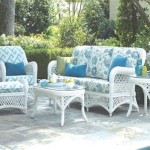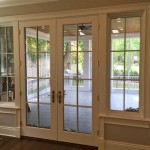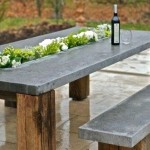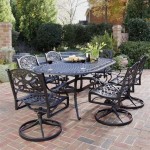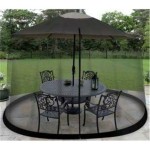Should You Cover Patio Furniture In The Winter Months?
The question of whether to cover patio furniture during the winter months is a recurring one for homeowners in regions experiencing significant seasonal changes. The answer, however, is not a simple yes or no. It depends on a confluence of factors, including the type of furniture, the severity of the local winter climate, and the availability of alternative storage options. Properly assessing these elements is crucial for making an informed decision that will protect the longevity and aesthetic appeal of outdoor furniture.
Leaving patio furniture exposed to the elements throughout the winter subjects it to a range of potentially damaging conditions. Snow, rain, ice, and fluctuating temperatures can all contribute to deterioration. Ultraviolet (UV) radiation, while less intense than in summer, can still cause fading and degradation of certain materials. Strong winds can damage lightweight furniture or blow debris onto and into the furniture, causing scratches and other cosmetic issues. Ultimately, understanding these potential risks is the first step in determining whether covering patio furniture is a necessary precaution.
Understanding the Material Composition of Your Patio Furniture
The specific materials comprising your patio furniture are a primary determinant in deciding whether covers are necessary. Different materials exhibit varying degrees of resistance to winter weather. For instance, aluminum and certain types of resin wicker are inherently more weather-resistant than wrought iron, wood, or upholstered pieces. The following provides a more detailed breakdown:
*Aluminum:
Aluminum is generally resistant to rust and corrosion, making it suitable for outdoor use, including winter conditions. However, prolonged exposure to moisture can still cause surface oxidation, which can dull the finish. While aluminum furniture may not require covering in mild winter climates, protection is advisable in areas with heavy snowfall and prolonged periods of freezing temperatures. *Wrought Iron:
Wrought iron is susceptible to rust, particularly in areas with high humidity or frequent precipitation. Even treated wrought iron can experience rust over time if the protective coating is compromised. Covering wrought iron furniture during the winter is highly recommended to prevent rust formation and maintain its structural integrity. *Wood:
Wood furniture, regardless of whether it's teak, cedar, or pine, is vulnerable to moisture damage. Repeated cycles of freezing and thawing can cause wood to crack, warp, and rot. While some types of wood, like teak, are naturally more resistant to weathering, all wood furniture benefits from protection during the winter months. Covering wood furniture helps minimize moisture absorption and prevents significant damage. *Resin Wicker:
High-quality resin wicker is typically designed to withstand outdoor conditions and is often UV-resistant. However, lower-grade resin wicker may become brittle and crack in cold temperatures. While not always essential, covering resin wicker furniture can extend its lifespan and prevent potential damage. It is important to ascertain the quality of the resin wicker before deciding whether to cover it. *Upholstered Furniture:
Upholstered cushions and fabrics are particularly vulnerable to water damage, mildew, and fading. These items should ideally be stored indoors during the winter. If indoor storage is not possible, covering upholstered furniture with waterproof covers is essential to prevent significant damage and maintain its appearance. Furthermore, consider the type of fabric. Some outdoor fabrics are designed to be water-resistant, while others are not.Before making a decision, consult the manufacturer's recommendations for your specific furniture. These recommendations often provide valuable insights into the best practices for winterizing and protecting your particular pieces.
Assessing the Severity of Your Local Winter Climate
The intensity and duration of winter weather in your specific geographic location are critical factors to consider. Regions with mild winters, characterized by infrequent snowfall and temperatures that rarely dip below freezing, may not necessitate covering patio furniture. However, areas experiencing heavy snowfall, prolonged periods of freezing temperatures, or frequent ice storms should strongly consider covering their outdoor furniture. Consider the following aspects:
*Snowfall:
Accumulating snow can place considerable weight on furniture, potentially causing structural damage, especially to items with intricate designs or weaker frames. Heavy snow can also seep into crevices and freeze, further exacerbating damage. *Freezing Temperatures:
Repeated cycles of freezing and thawing can cause water to penetrate the furniture's surface, leading to cracking, warping, and delamination of finishes. Materials like wood and certain plastics are particularly susceptible to this type of damage. *Ice Storms:
Ice storms can coat furniture with a thick layer of ice, which can be incredibly heavy and damaging. The weight of the ice, combined with the potential for branches and debris to fall on the furniture, presents a significant risk. *Wind:
Strong winds can damage lightweight furniture or blow debris onto and into the furniture, leading to scratches and other cosmetic issues. Consider the typical wind patterns in your area to determine the likelihood of wind-related damage.Beyond the general climate, consider the microclimate of your specific property. A patio exposed to strong winds and direct sunlight will experience harsher conditions than a sheltered patio located under a covered porch.
Exploring Alternatives to Covering Patio Furniture
While covering patio furniture is a common practice, it is not the only option for winterizing outdoor pieces. Indoor storage is often the most effective method of protection, particularly for valuable or delicate items. However, space constraints may make indoor storage impractical for many homeowners. Other alternatives include:
*Indoor Storage:
Storing patio furniture in a garage, shed, or basement provides the best protection against the elements. This option is particularly suitable for cushions, pillows, and other upholstered items, as well as furniture made from less durable materials. *Designated Storage Areas:
If garage or basement space is limited, consider creating a designated storage area in your yard. This could involve building a simple shed or using a large storage container to house your patio furniture during the winter months. *Grouping and Elevating Furniture:
If covering or storing furniture is not feasible, consider grouping the pieces together in a sheltered area of your patio. Elevating the furniture off the ground using blocks or risers can help prevent moisture damage and improve air circulation. *Applying Protective Treatments:
For wood furniture, applying a sealant or water repellent can help minimize moisture absorption and prevent damage. For metal furniture, applying a rust inhibitor can help protect against corrosion.The choice between covering, storing, or treating patio furniture depends on individual circumstances and priorities. However, carefully considering all available options and selecting the most appropriate method for your specific needs can significantly extend the lifespan of your outdoor furniture.
Selecting the appropriate type of cover is also crucial. A breathable, waterproof cover is ideal, as it allows moisture to escape while preventing rain and snow from penetrating. Avoid using plastic tarps, as they can trap moisture and create a breeding ground for mold and mildew. Ensure the cover fits snugly and securely to prevent it from being blown away by the wind. Furthermore, inspect the covers regularly for any tears or damage and repair them promptly to maintain their protective effectiveness.
In summary, determining whether to cover patio furniture during the winter requires a thorough evaluation of the furniture's material composition, the severity of the local climate, and the availability of alternative storage options. By carefully considering these factors and implementing appropriate protective measures, homeowners can safeguard their outdoor furniture and extend its lifespan, ensuring its continued enjoyment for years to come.

How To Protect Your Patio Furniture During The Winter Months Devries

Winter Storage Tips For Patio Furniture Peterborough Landscape Supply

3 Tips For Storing Patio Furniture Over The Winter Mostly Danish Ottawa

How To Prepare Outdoor Furniture For The Winter

What To Do With Patio Furniture In Winter Canadian Home Leisure

How To Use Outdoor Furniture In Winter

Shrink Wrapping Little Silver Nj Clearview Washing

S Top Rated Furniture Cover Will Winter Proof Your Outdoor Setup Against Bad Weather Ok

How To Properly And Maintain Outdoor Furniture Sparefoot Blog

Protect Your Outdoor Cushions Over The Holiday Season Patio Furniture Cushion Covers
Related Posts


